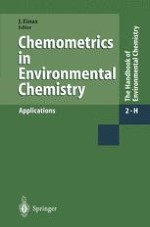1995 | OriginalPaper | Buchkapitel
The Mixture Resolution Problem Applied to Airborne Particle Source Apportionment
verfasst von : Philip K. Hopke
Erschienen in: Chemometrics in Environmental Chemistry - Applications
Verlag: Springer Berlin Heidelberg
Enthalten in: Professional Book Archive
Aktivieren Sie unsere intelligente Suche, um passende Fachinhalte oder Patente zu finden.
Wählen Sie Textabschnitte aus um mit Künstlicher Intelligenz passenden Patente zu finden. powered by
Markieren Sie Textabschnitte, um KI-gestützt weitere passende Inhalte zu finden. powered by
The problem of source identification and quantitative mass apportion for airborne particulate matter commonly called receptor modeling is much the same as the spectrochemical mixture or the multivariate calibration problems commonly encountered in chemometrics. However, there are some important differences that occur for the receptor modeling problem including variability in the source profiles (corresponding to the spectral properties of the mixture components), transformation of the profiles while in transit from the emission sources to the sampling sites, and much larger errors (noise) in the sampling and analysis of the mixtures. Various mixture resolution approaches have been used including multiple linear regression (Chemical Mass Balance Model) and various type of factor analysis. The basis for these methods is presented and illustrative examples of each are given. In addition multivariate calibration methods including partial least squares, the genetic algorithm, and artificial neural networks are now being explored as ways to solve the receptor modeling problem. These methods as well as the limited applications of these approaches are also reviewed. The initial results with these methods are promising, but further development and testing are needed before they can be used as commonly as the chemical mass balance or factor analysis models.
